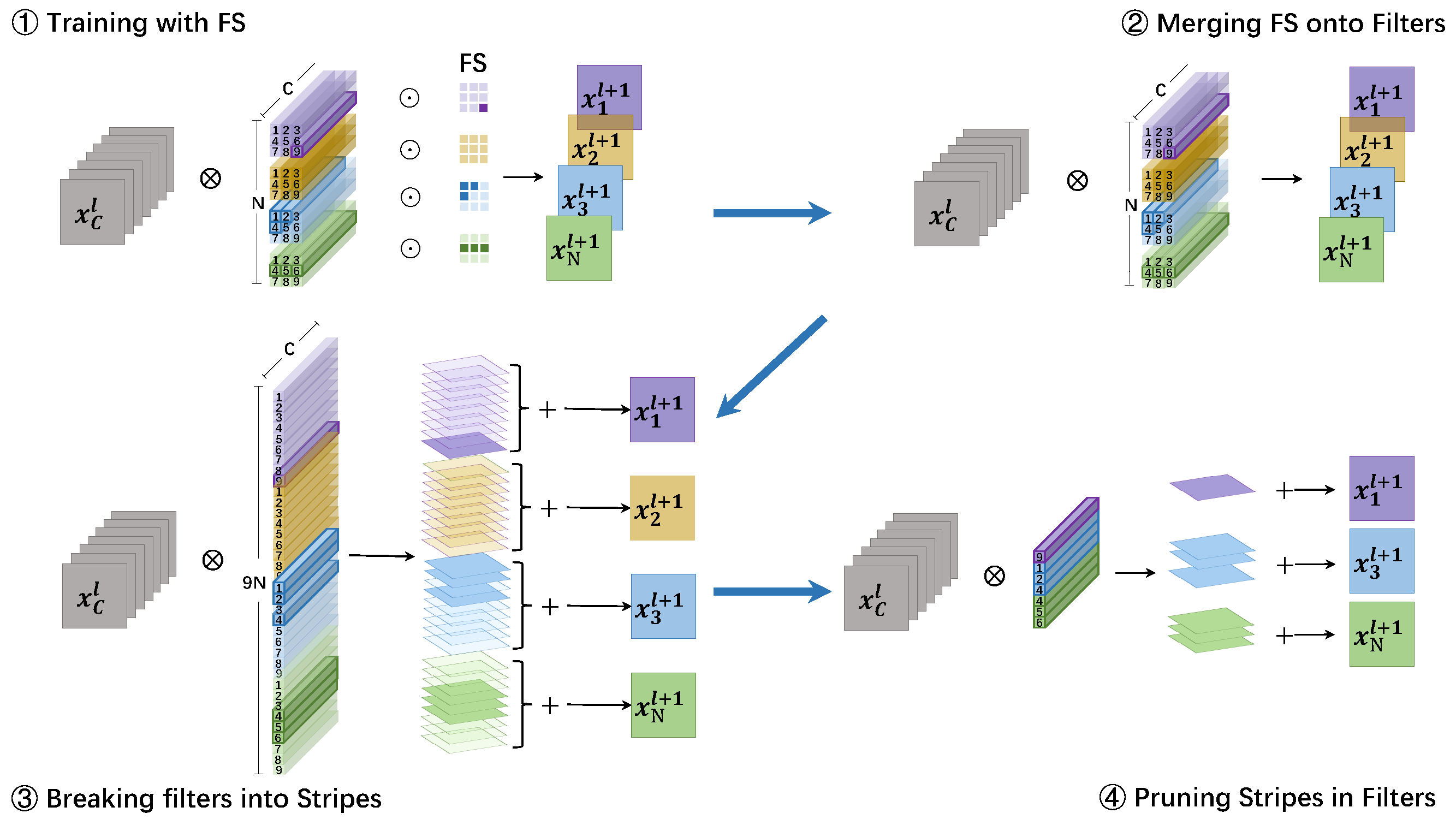This is the PyTorch implementation of our NeurIPS 2020 paper "Pruning Filter in Filter". In this paper:
-
We propose a new pruning paradigm called Stripe-wise-Pruning(SP), which can be seen as a general case of the Filter-Pruning (FP). SP treats a filter $F \in \mathbb{R}^{C\times K\times K}$as
$K\times K$ stripes (i.e.,$1\times 1$ filters $\in \mathbb{R}^c $ ), and perform pruning at the unit of stripe instead of the whole filter. Compared to the existing methods, SP achieves finer granularity than traditional FP while being hardware friendly than Weight-Pruning and keeping independence between filters than Group-wise-Pruning, leading to state-of-the-art pruning ratio on CIFAR-10 and ImageNet. -
More arousingly, by applying SP, we find another important property of filters alongside their weight: shape. Start with a random initialized ResNet56, we train and trim the shape of filters and boost the test accuracy to 80.58% on CIFAR-10 without updating the filter weights. The optimal shape of filters are learned by the proposed Filter-Skeleton (FS) in the paper and we believe FS could inspire further research towards the essence of network pruning.
python3.7
pytorch1.4.0
torchvision0.5.0
mkdir -p checkpoint/VGG/baseline
python main.py --arch VGG --data_path ../data --save checkpoint/VGG/baseline
mkdir -p checkpoint/ResNet56/baseline
python main.py --arch ResNet56 --data_path ../data --save checkpoint/ResNet56/baselinemkdir -p checkpoint/VGG/sr0.00001_threshold_0.01
python main.py --arch VGG --data_path ../data --sr 0.00001 --threshold 0.01 --save checkpoint/VGG/sr0.00001_threshold_0.01
mkdir -p checkpoint/ResNet56/sr0.00001_threshold_0.01
python main.py --arch ResNet56 --data_path ../data --sr 0.00001 --threshold 0.01 --save checkpoint/ResNet56/sr0.00001_threshold_0.01
Backbone Metrics Params(%) $\downarrow$ FLOPS(%) $\downarrow$ Accuracy(%)$\downarrow$ VGG16 L1 64 34.3 -0.15 ThiNet 63.95 64.02 2.49 SSS 73.8 41.6 0.23 SFP 63.95 63.91 1.17 GAL 77.6 39.6 1.22 Hinge 80.05 39.07 -0.34 HRank 82.9 53.5 -0.18 Ours 92.66 71.16 -0.4 ResNet56 L1 13.7 27.6 -0.02 CP --- 50 1.00 NISP 42.6 43.6 0.03 DCP 70.3 47.1 -0.01 IR --- 67.7 0.4 C-SGD --- 60.8 -0.23 GBN 66.7 70.3 0.03 HRank 68.1 74.1 2.38 Ours 77.7 75.6 0.12 Backbone Metrics FLOPS(%) $\downarrow$ Top-1(%) $\downarrow$ Top-5(%)$\downarrow$ ResNet18 LCCL 35.57 3.43 2.14 SFP 42.72 2.66 1.3 FPGM 42.72 1.35 0.6 TAS 43.47 0.61 -0.11 DMCP 42.81 0.56 --- Ours( $\alpha =5e-6$ )50.48 -0.23 -0.22 Ours( $\alpha =2e-5$ )54.58 0.17 0.04
If you find this code useful, please cite the following paper:
@article{Meng2020PruningFI,
title={Pruning Filter in Filter},
author={Fan-Xu Meng and Hao Cheng and Ke Li and Huixiang Luo and Xiao-wei Guo and G. Lu and Xing Sun},
journal={ArXiv},
year={2020},
volume={abs/2009.14410}
}
For CIFAR, our code is based on https://github.com/Eric-mingjie/rethinking-network-pruning
For ImageNet, our code is based on https://github.com/pytorch/examples/tree/master/imagenet
